Welcome to the ultimate beginner’s guide on garden edging! In this article, I will walk you through the basics of garden edging, provide you with creative ideas, and teach you how to create your own DIY garden edging projects.
Garden edging is essential for creating distinct borders between different areas of your landscape. By defining borders, garden edging helps bring order and organization to your outdoor space.
Key Takeaways:
- There are three main categories of garden edging: landscape edging, border fencing, and mulch edging.
- Landscape edging creates crisp borders between surface materials, prevents mulch from scattering, and deters weeds from infiltrating flower beds.
- Border fencing adds a decorative element and creates borders between gardens and sidewalks, while keeping walkways open.
- Mulch edging provides a wide border that keeps weeds at bay, protects tree trunks from damage, and won’t scatter like regular mulch.
- When choosing garden edging, consider the purpose, site conditions, and your style or material preferences.
Garden edging can be made from a variety of materials, including metal, plastic, wood, natural rock, pavers, brick, and concrete. Each material has its own unique features and benefits, so you can choose the one that best suits your aesthetic preferences and practical needs.
To install garden edging, start by mowing the lawn and choosing the appropriate tools for edging and trimming. Plan out your project and follow the proper techniques for using a lawn edger, string trimmer, or manual edger. Regular maintenance is necessary to keep the edges looking neat, such as routine mowing, trimming, and cleaning up debris.
By incorporating garden edging into your landscape design, you can create a polished and well-maintained outdoor space that enhances the beauty of your garden. Stay tuned for more tips and ideas on garden edging in the upcoming sections of this guide!
Why Garden Edging Matters
Before we dive into the nitty-gritty of garden edging techniques, let’s explore why garden edging matters and the amazing benefits it can bring to your outdoor space. Garden edging is not just a decorative element, but an essential aspect of landscaping that serves multiple purposes.
Garden edging creates distinct borders between different areas in your landscape, such as flower beds, lawns, pathways, and driveways. It helps define these areas and prevents them from blending into one another, giving your garden a more polished and organized appearance. With well-defined borders, you can easily separate plants from grass, keeping them neatly contained and preventing the spread of weeds.
Garden edging also plays a crucial role in maintaining the health of your plants and flowers. It prevents mulch from scattering, ensuring it stays in place and retains moisture around the plants’ roots. By creating a barrier between the mulch and the surrounding soil, garden edging helps to retain moisture and nutrients, promoting healthy growth. Additionally, the edging acts as a deterrent to weeds, preventing them from infiltrating the flower beds and competing with your plants for essential resources.
Furthermore, garden edging adds aesthetic appeal to your outdoor space. It acts as a frame, highlighting the beauty of your plants and flowers while providing a clean and finished look. With a wide range of materials and designs available, you can choose edging options that complement your overall landscape style.
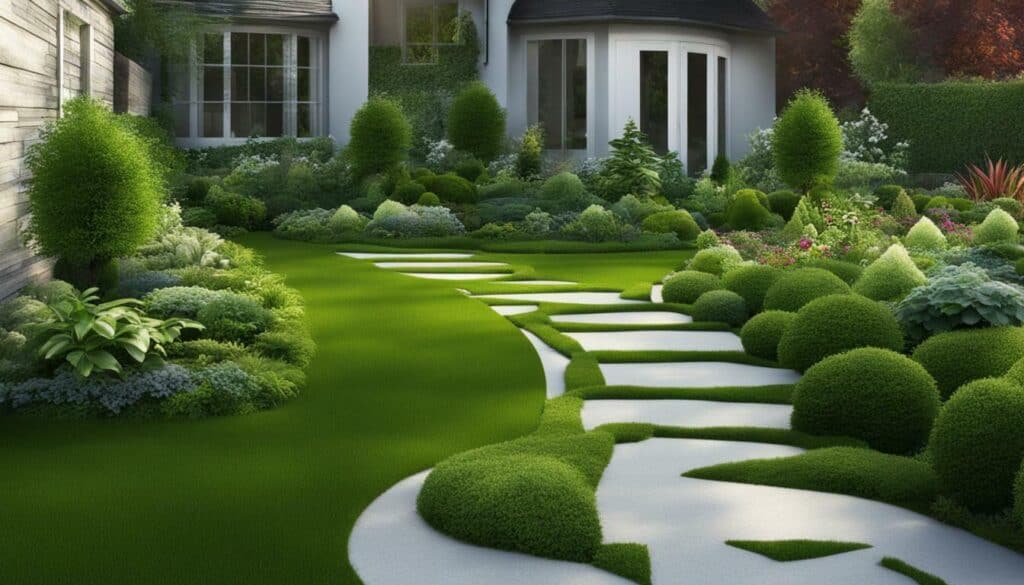
As you can see, garden edging is more than just a decorative feature. It serves functional purposes, such as creating borders, preventing mulch scattering, and deterring weeds, while also enhancing the visual appeal of your garden. In the next sections, we will explore the different types of garden edging, how to choose the right one for your needs, and the techniques for installation and maintenance.
Different Types of Garden Edging
When it comes to garden edging, there are various options to choose from. Let’s explore the different types of garden edging, including landscape edging, border fencing, and mulch edging, and discover the best materials for each.
| Types of Garden Edging | Best Materials |
|---|---|
| Landscape Edging | Metal: Provides a sleek and modern look. Plastic: Affordable and easy to install. Wood: Offers a natural and rustic appearance. |
| Border Fencing | Natural Rock: Adds an organic and textured feel. Pavers: Provides a sturdy and durable option. Brick: Offers a classic and timeless aesthetic. |
| Mulch Edging | Concrete: Provides a clean and elegant border. Plastic: Offers a cost-effective and flexible choice. |
Each type of garden edging serves a specific purpose and comes with its own advantages. Landscape edging is installed to be visible at the soil surface or just a few inches above it and helps create crisp borders between surface materials, prevents mulch from scattering, and deters weeds from infiltrating flower beds. Border fencing adds a decorative element to your garden and creates borders between gardens and sidewalks, while also keeping walkways open and accessible. Mulch edging provides a wide border to keep weeds at bay, won’t scatter like regular mulch, and protects tree trunks from damage.
When choosing the right edging for your garden, consider the purpose you want it to serve, your site conditions, and your personal style or material preferences. Metal, plastic, wood, natural rock, pavers, brick, and concrete are all popular choices for garden edging materials. Each material offers its own unique features and benefits, so you can select the one that best suits your needs and complements your overall landscape design.
Installing garden edging requires careful planning and execution. Start by mowing the lawn and cleaning up the area where you want to install the edging. Choose the appropriate tools for edging and trimming, such as a lawn edger, string trimmer, or manual edger, depending on your specific requirements. Plan out the project, ensuring you measure and mark the desired borders accurately. Then, follow the proper techniques for installing the selected type of garden edging, ensuring it is securely placed and aligned.

Benefits of Garden Edging
“Garden edging adds structure and definition to your outdoor space, ensuring it looks well-maintained and visually appealing.”
Garden edging not only enhances the aesthetics of your landscape but also provides several practical benefits. By creating distinct borders between different areas of your garden, edging helps to organize and define different sections, creating a sense of order and structure. This can be particularly useful if you have various surface materials, such as lawn, flower beds, and mulched areas, that need to be separated.
Furthermore, garden edging prevents mulch from scattering onto your lawn or walkways, keeping your outdoor space clean and tidy. It also acts as a barrier, deterring weeds from infiltrating your flower beds and reducing the amount of time and effort you need to spend on weed control. Additionally, edging adds a decorative element to your garden, enhancing its overall appearance and making it more visually appealing.
In summary, garden edging is essential for creating a polished and well-maintained landscape. By choosing the right type of edging and installing it correctly, you can enjoy the benefits of defined borders, weed prevention, and enhanced aesthetics in your outdoor space.
Choosing the Right Garden Edging
With so many options available, choosing the right garden edging can be overwhelming. Fear not! In this section, I will guide you through the process of selecting the perfect garden edging that matches your needs and complements your landscape design.
Factors to Consider:
- The Purpose: Determine the main function of your garden edging. Is it to create distinct borders between different areas of your landscape? Or is it to add a decorative element?
- Site Conditions: Consider the specific conditions of your garden, such as soil type, drainage, and exposure to sunlight. Some materials may be better suited for certain conditions than others.
- Style and Material Preferences: Think about your personal style and the overall aesthetic you want to achieve. Do you prefer a more natural look with materials like wood or stone? Or do you lean towards modern and sleek designs with metal or concrete?
Popular Garden Edging Materials:
| Material | Pros | Cons |
|---|---|---|
| Metal | Durable and long-lasting, adds a modern touch | Can be expensive, may rust over time |
| Plastic | Affordable, easy to install and maintain | May fade or become brittle with prolonged exposure to sunlight |
| Wood | Natural and timeless look | Requires regular sealing or staining to maintain appearance |
| Natural Rock | Provides a rustic, organic feel | Heavy and may be challenging to install |
| Pavers | Versatile and available in various shapes and colors | Can be more expensive than other materials |
| Brick | Classic and timeless, adds charm to any garden | Requires mortar for a secure installation |
| Concrete | Durable and low-maintenance | May crack over time |
Remember: The right garden edging should not only be functional but also enhance the overall beauty and appeal of your landscape. Consider your needs, preferences, and site conditions to make an informed decision. Don’t be afraid to get creative and think outside the box!
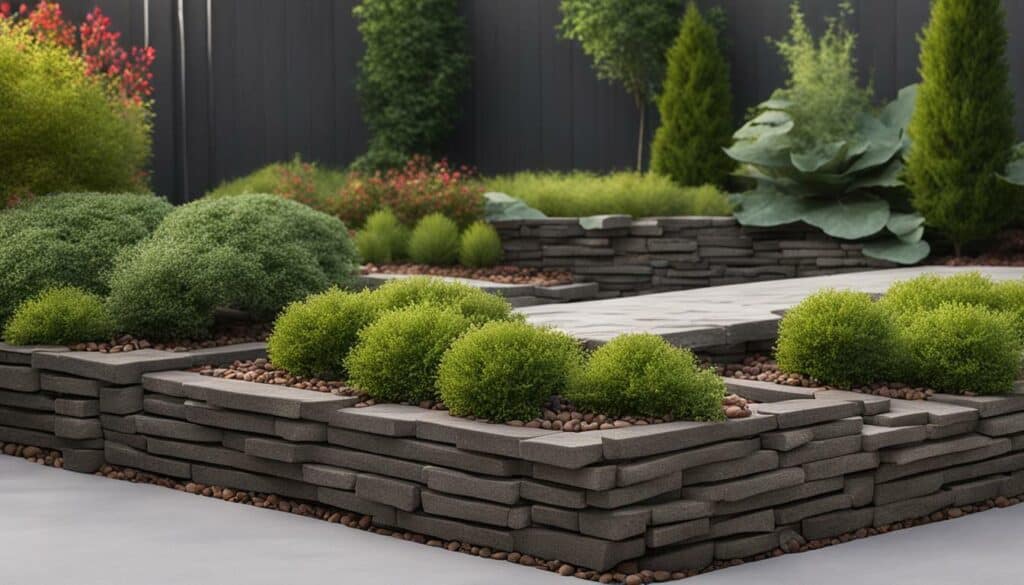
Expert Tip:
“When choosing garden edging, take into account the maintenance requirements as well. Some materials may require more upkeep than others. Consider the long-term implications of your choice to ensure a beautiful and hassle-free garden.” – John Green, Landscape Designer
Installing Garden Edging
Now that you’ve chosen your ideal garden edging, it’s time to roll up your sleeves and install it! In this section, I will walk you through the step-by-step process of installing garden edging like a pro.
Before you begin, gather all the necessary tools and materials. You will need a lawn edger or a manual edger, a string trimmer or a pair of garden shears, a shovel, a rubber mallet, a level, landscape stakes, and of course, your chosen garden edging material. It’s also a good idea to wear gloves to protect your hands during the installation.
Step 1: Prepare the area. Start by marking out the desired pathway or garden bed with stakes and string. Use a shovel to remove any existing grass, roots, or debris along the edges. Ensure the ground is level and clear of any obstacles.
Step 2: Dig a trench. Using a shovel, dig a trench along the marked line to accommodate the depth and width of your garden edging. The depth will depend on the height of the edging material you’re using. Aim for a trench that is snug enough to hold the edging securely in place.
Step 3: Install the garden edging. Carefully position the garden edging into the trench, making sure it is level and aligned with the desired pathway or garden bed. Use a rubber mallet to gently tap the edging into place, ensuring it is firmly anchored in the soil. Repeat this step for the entire length of the trench.
Step 4: Secure the edging. To prevent the edging from shifting or moving, insert landscape stakes into the ground at regular intervals along the length of the edging. Drive the stakes into the soil using a rubber mallet, ensuring they are securely holding the edging in place.
Step 5: Finishing touches. Once the edging is securely installed, backfill any gaps or spaces around the edging with soil. Use a level to double-check the alignment and adjust if needed. Finally, give your newly installed garden edging a thorough watering to help settle the soil.
Congratulations! You have successfully installed your garden edging and added a beautiful finishing touch to your landscape. Now sit back, relax, and enjoy the enhanced curb appeal and neatness that garden edging brings to your outdoor space.
Tips for Installing Garden Edging:
- Ensure the ground is well-prepared and level before installing the edging.
- Consider using a string line to maintain a straight edge during installation.
- If using flexible garden edging, make sure to bend it gently and secure it with stakes to maintain its shape.
- For added stability, backfill the trench with soil and tamp it down firmly around the edging.
- Regularly inspect and adjust the edging as needed to keep it in proper alignment.
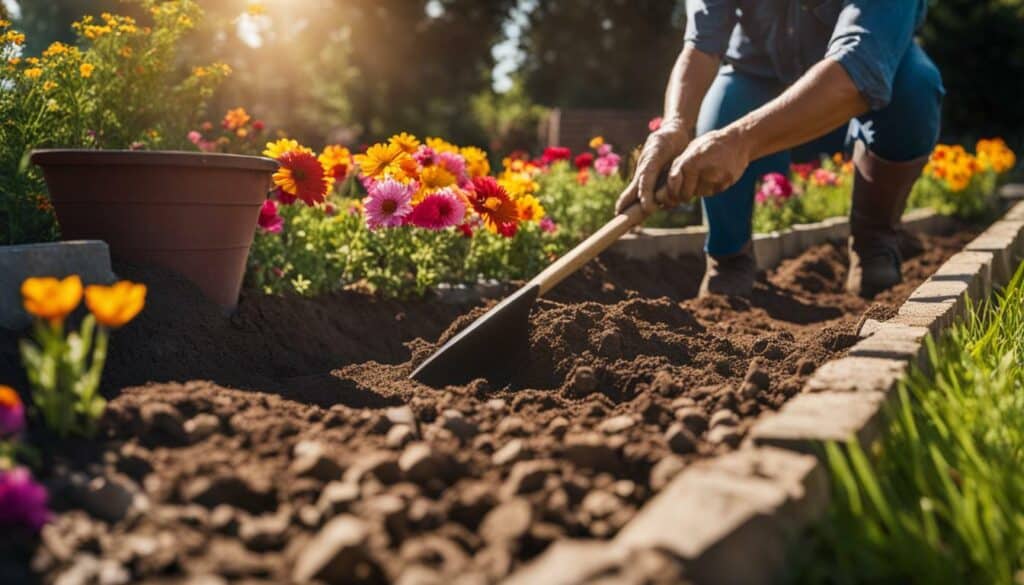
| Pros | Cons |
|---|---|
| Creates distinct borders and defined areas in your garden | Requires some effort and manual labor |
| Prevents mulch from scattering and deters weeds | May require regular maintenance to keep edges looking neat |
| Adds aesthetic appeal and enhances the overall look of your landscape | Choice of materials may be limited based on personal preference and budget |
Maintaining Garden Edging
Congratulations on your newly installed garden edging! But remember, the work doesn’t stop there. In this section, I will share essential maintenance tips to ensure that your garden edging stays in top shape year-round.
To keep your garden edging looking neat and well-maintained, regular maintenance is necessary. Here are some helpful tips:
- Routine Mowing: Regularly mow your lawn to keep grass from encroaching on your garden edging. This will help maintain clean, defined borders and prevent the edging from being overrun.
- Trimming: Use a string trimmer or manual edger to trim the grass along the edges of your garden bed. This will help create a crisp, clean line and prevent any unwanted vegetation from encroaching on your flower beds or walkways.
- Cleaning up Debris: Regularly remove debris, such as leaves, twigs, and grass clippings, from your garden edging. This will help prevent clogs and keep the edges looking tidy.
Remember to inspect your garden edging regularly for any signs of damage or wear. If you notice any issues, such as loose or broken edging, take prompt action to repair or replace it to maintain its functionality and aesthetics.

| Material | Pros | Cons |
|---|---|---|
| Metal | Durable, versatile, and visually appealing | May rust over time, higher cost |
| Plastic | Lightweight, affordable, and easy to install | Less durable, may fade or become brittle |
| Wood | Natural, blends well with garden surroundings | Prone to rot, requires regular maintenance |
| Natural Rock | Durable, adds a rustic charm to the garden | Heavy, may be challenging to install |
| Pavers | Wide range of styles and patterns available | Requires proper base preparation and installation |
| Brick | Classic and timeless appearance | Can be labor-intensive to install |
| Concrete | Durable, versatile, and long-lasting | May crack over time, heavier to work with |
By following these garden edging maintenance tips, you can ensure that your landscape always looks its best. With proper care and attention, your garden edging will continue to enhance the beauty and functionality of your outdoor space for years to come.
Exploring Different Garden Edging Materials
Are you curious about the different materials you can use for garden edging? Look no further! In this section, we will take a closer look at the pros and cons of popular garden edging materials.
When it comes to garden edging, there is a wide range of materials to choose from, each with its own unique advantages and considerations. Let’s explore some of the most popular options:
| Material | Pros | Cons |
|---|---|---|
| Metal | Sturdy and durable, adds a sleek and modern look to the landscape | Can be more expensive, may corrode or rust over time |
| Plastic | Lightweight, affordable, and easy to install | May fade or become brittle under prolonged sun exposure |
| Wood | Natural and blends well with garden surroundings | Requires regular maintenance, can rot or warp over time |
| Natural Rock | Provides a rustic and natural look, highly durable | Heavy and difficult to install, can be more expensive |
These are just a few examples of the materials available for garden edging. By considering the specific requirements of your landscape, such as the desired aesthetic, durability, and maintenance needs, you can choose the best material that suits your preferences and budget.
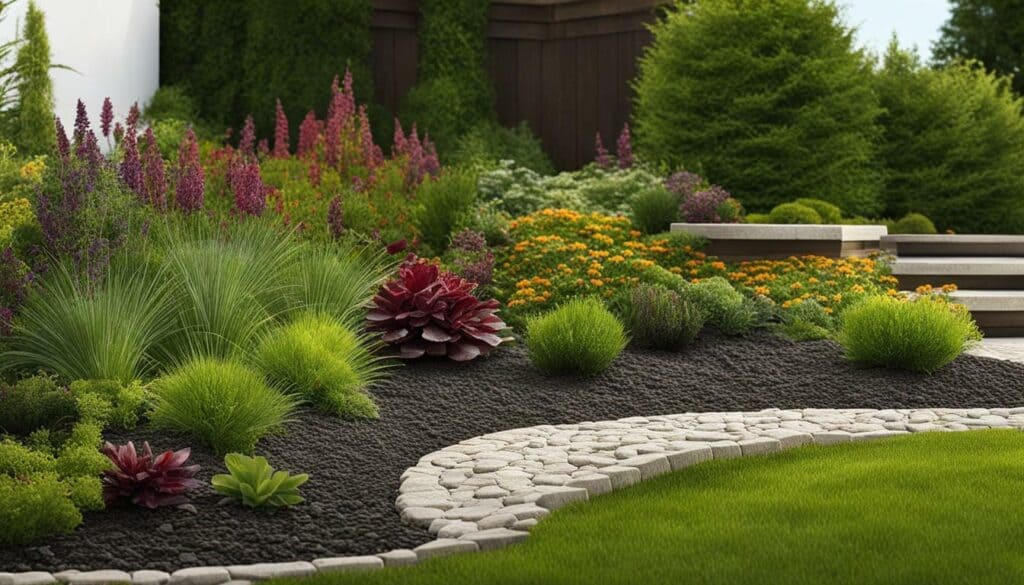
As you explore different garden edging materials, it’s important to remember that combining different materials can also create visually appealing and unique designs. For example, pairing natural rock with metal or wood can add an interesting contrast to your garden borders.
Now that you have a better understanding of the different garden edging materials available, you can make an informed decision that will complement your landscape and elevate the overall look of your garden.
Creative DIY Garden Edging Ideas
Ready to get your creative juices flowing? In this section, I will share a collection of creative DIY garden edging ideas that will transform your outdoor space into a stunning masterpiece. Whether you have a small backyard or a spacious garden, these unique edging projects will add a touch of beauty and charm to your landscape.
1. Wine Bottle Border
Add a whimsical touch to your garden by repurposing empty wine bottles as a colorful border. Simply dig a trench along the edge of your garden bed and bury the bottles halfway, neck down. Arrange the bottles in a pattern or mix and match different colors for a vibrant display. This eco-friendly idea not only adds visual interest but also helps reduce waste.
2. Pallet Wood Pathway
Transform discarded pallets into a rustic pathway that guides visitors through your garden. Dismantle the pallets and use the wooden planks to create a durable pathway. Arrange the planks vertically, leaving a small gap between them for drainage. Secure them in place with stakes, and voila! You have an eye-catching and cost-effective garden walkway.
3. Mosaic Garden Edge
Add a touch of artistry to your garden with a mosaic garden edge. Collect colorful broken tiles, glass, or pottery, and arrange them in a desired pattern along the edge of your flower bed or pathway. Use mortar or adhesive to affix the pieces to a sturdy base, such as bricks or concrete blocks. The result is a stunning and unique garden edging that showcases your creativity.
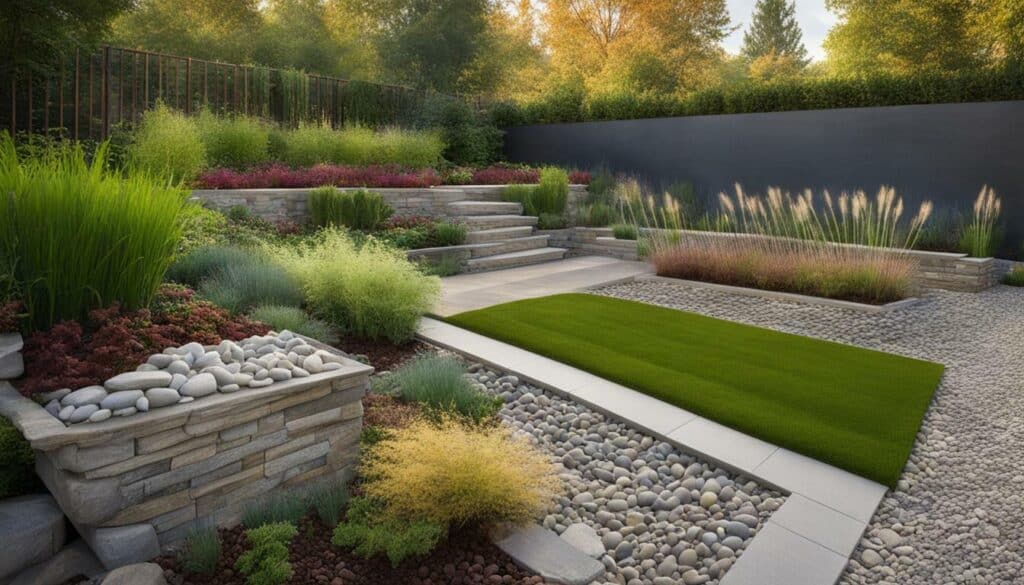
These are just a few examples of the countless DIY garden edging ideas you can explore. The key is to let your imagination run wild and find materials that resonate with your style and personality. Whether you choose to repurpose household items, use natural elements, or get crafty with mosaic designs, your garden will be transformed into a visually striking oasis.
| Benefits: | Materials Needed: |
|---|---|
|
|
Garden Edging Inspirations Across the US
Let’s take a virtual tour across the United States to explore breathtaking garden edging inspirations that will leave you in awe and spark your own creativity. From coast to coast, gardens across the country showcase unique edging designs that add charm, sophistication, and character to outdoor spaces.
In New York City’s Central Park, the Shakespeare Garden stands out with its meticulously maintained flower beds bordered by elegant stone edging. The precision and attention to detail in this garden is truly remarkable, making it a popular spot for weddings and photo shoots. The stone edging not only creates distinct borders but also complements the classical aesthetic of the garden.
Heading west to California, the Getty Center in Los Angeles boasts stunning gardens with edging that seamlessly blends into the surrounding landscape. The use of low-profile concrete edging allows the vibrant colors and delicate textures of the plants to take center stage. This minimalistic approach creates a harmonious balance between the natural and the man-made, enhancing the overall beauty of the gardens.
In the heartland of America, the Chicago Botanic Garden showcases a variety of edging styles that elevate the visual appeal of their outdoor spaces. From brick edging that adds a touch of rustic charm to metal edging that delivers a modern and sleek aesthetic, there is something to inspire every garden enthusiast. The thoughtful combination of different materials creates a dynamic and visually interesting landscape that captivates visitors.
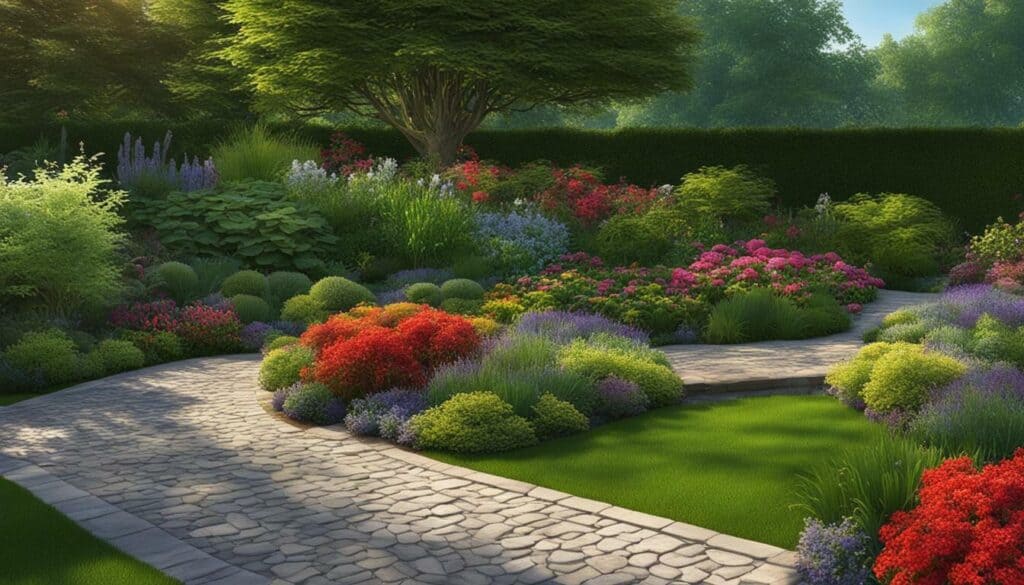
Brick Edging in Chicago Botanic Garden
“The precision and attention to detail in this garden is truly remarkable, making it a popular spot for weddings and photo shoots.”
These are just a few examples of the stunning garden edging inspirations found across the United States. No matter where you are, there are endless possibilities to create unique and beautiful borders in your own garden. So, go ahead and let your imagination run wild as you explore different garden edging ideas and bring a touch of artistic flair to your outdoor oasis.
Tips for Enhancing Your Garden Edging
Want to take your garden edging to the next level? Follow these expert tips for enhancing your garden edging and adding that extra wow factor to your outdoor space.
1. Add Lighting: Create a magical ambiance in your garden by incorporating lighting into your garden edging. Use solar-powered lights or LED strips to highlight the edges and create a warm and inviting atmosphere. This not only enhances the aesthetic appeal of your garden but also provides safety and security during nighttime.
2. Integrate Plants or Flowers: Take your garden edging up a notch by incorporating plants or flowers along the border. Plant colorful flowers or ornamental grasses to create a beautiful and vibrant contrast against the edging materials. This not only adds visual interest but also softens the edges, giving your garden a more organic and natural look.
3. Create Continuity: Ensure that your garden edging seamlessly blends with the rest of your landscape design by creating continuity. Choose edging materials that complement the overall theme of your garden and tie in with other elements such as pathways, patios, or planters. This cohesive design approach creates a harmonious and well-integrated outdoor space.
| Tips for Enhancing Your Garden Edging |
|---|
| Add Lighting |
| Integrate Plants or Flowers |
| Create Continuity |
“The right lighting and the perfect combination of plants can transform your garden edging into a stunning focal point.” – Gardening Expert
By following these expert tips, you can elevate your garden edging from functional to fabulous. Whether you choose to add lighting, integrate plants or flowers, or create continuity, these enhancements will surely make your garden stand out. So, get creative and make your outdoor space truly extraordinary.

References:
- https://www.bhg.com.au/
- https://www.gardendesign.com/
Conclusion
Congratulations! You are now equipped with all the knowledge you need to unlock the basics of garden edging and transform your outdoor space into a beautiful haven. Remember, garden edging is the secret to achieving a picture-perfect landscape that will impress everyone who sets foot in your garden.
By understanding the benefits of garden edging and the different types available, you can create distinct borders between different areas, prevent mulch from scattering, and deter weeds from infiltrating flower beds. Whether you choose landscape edging, border fencing, or mulch edging, each option serves a specific purpose in creating crisp borders and defining different areas of your garden.
When choosing the right garden edging, consider the purpose of the edging, your site conditions, and your personal style or material preferences. You have a wide range of materials to choose from, including metal, plastic, wood, natural rock, pavers, brick, and concrete. Each material has its own unique features and benefits, allowing you to create a customized garden design.
Installing garden edging requires proper planning and technique. Follow the step-by-step instructions provided to prepare the area, choose the appropriate tools, and use a lawn edger, string trimmer, or manual edger effectively. Once installed, regular maintenance is necessary to keep the edges looking neat and well-maintained.
Now that you have the knowledge and understanding of garden edging, it’s time to put your creativity to work. Explore different DIY ideas and get inspired by iconic gardens across the United States. Enhance your garden edging with lighting, plants, and other design elements to create a truly stunning landscape.
Remember, garden edging is not just about creating borders; it’s about elevating your outdoor space and showcasing your unique style. So go ahead, take the leap, and transform your garden into a work of art with the power of garden edging!
What Are Some Tips for Creating Garden Edging in a Basic Garden Train Layout?
When creating a basic garden train layout, incorporating garden edging is crucial. It helps define the boundaries and enhances the overall visual appeal of the design. To achieve this, start by selecting appropriate materials such as bricks, stones, or even plants. Ensure the edging blends well with the theme and scale of the layout. Utilize this basic garden train layout creation guide for easy and effective garden edging implementation.
FAQ
Q: Why is garden edging important?
A: Garden edging is important for creating distinct borders between different areas of your landscape. It helps create crisp borders between surface materials, prevents mulch from scattering, and deters weeds from infiltrating flower beds.
Q: What are the different types of garden edging?
A: There are three main categories of garden edging: landscape edging, border fencing, and mulch edging. Landscape edging is installed to be visible at the soil surface or just a few inches above it. Border fencing adds a decorative element and creates borders between gardens and sidewalks. Mulch edging provides a wide border to keep weeds at bay and protects tree trunks from damage.
Q: How do I choose the right garden edging?
A: When choosing the right garden edging, consider the purpose, your site conditions, and your style or material preferences. There are various materials you can choose from, including metal, plastic, wood, natural rock, pavers, brick, and concrete.
Q: How do I install garden edging?
A: To install garden edging, start by mowing the lawn, choose the appropriate tools for edging and trimming, plan out the project, and follow the proper techniques for using a lawn edger, string trimmer, or manual edger.
Q: How do I maintain garden edging?
A: Regular maintenance is necessary to keep the edges looking neat. This includes routine mowing, trimming, and cleaning up debris.
Q: What are some creative DIY garden edging ideas?
A: There are plenty of creative DIY garden edging ideas that you can try. Some examples include using recycled materials, creating a mosaic pattern, or incorporating plants and flowers into the edging design.

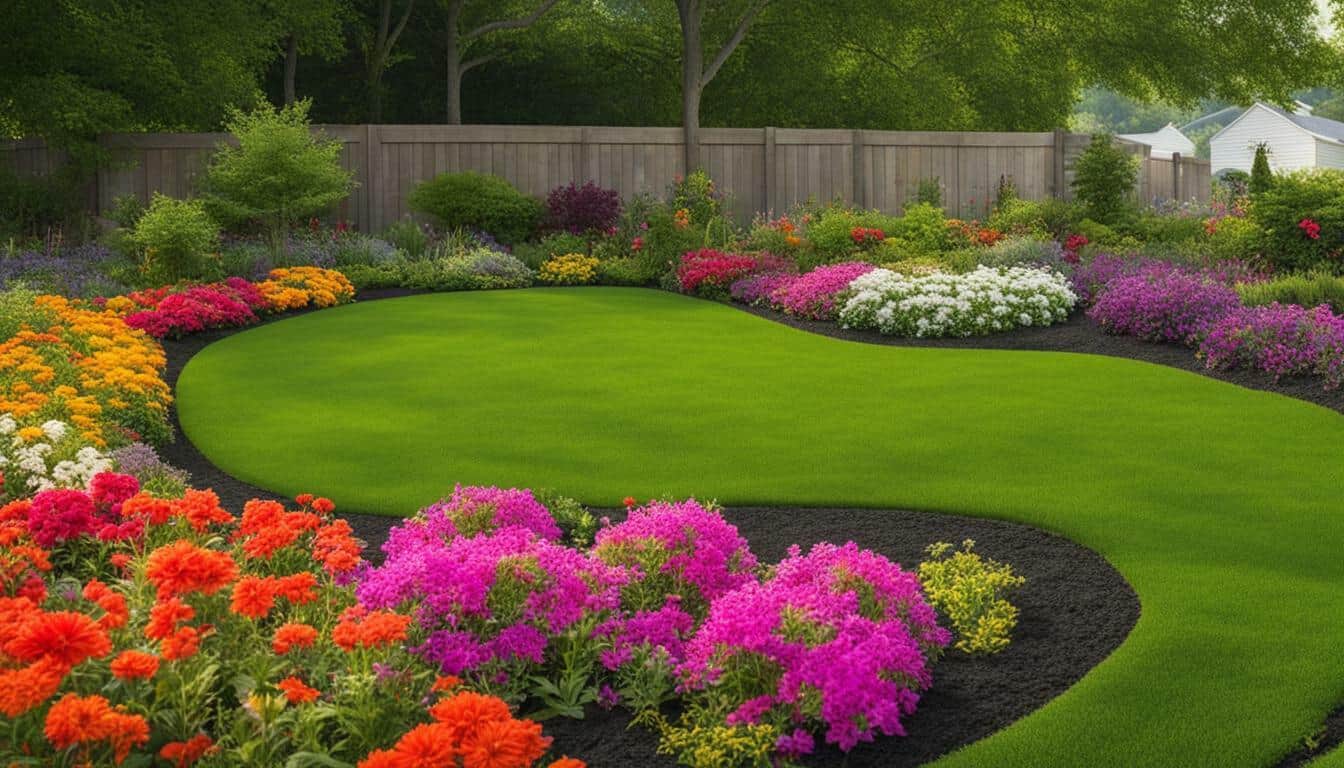




Leave a Reply